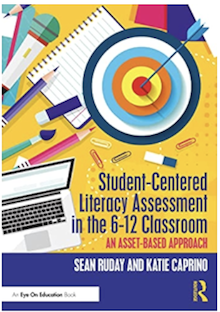Shifting to Asset-Based Literacy Assessments
Student-Centered Literacy Assessment in the 6-12 Classroom: An Asset-Based Approach
By Sean Ruday and Katie Caprino
(Routledge/Eye On Education, 2023 – Learn more)
Reviewed by Theresa Wood

Although I was learning alongside my students, I was proud of their podcast episodes, infographics, websites, and videos. I was eager to develop these kinds of assessments further, but my colleague cut me off saying that essays were really expected and required and I should focus on them.
While I agree that it is important for students to be able to develop and support a claim with reliable evidence, I felt in my heart that clinging to this as the only valuable form of assessment was misguided, but I did not know how to challenge her assertion.

This slim volume details coauthor Sean Ruday’s experience in assessing his ninth graders by incorporating modalities and topics of interest to them. While the modalities themselves are not new, Ruday’s approach to learning about his students and what they value while incorporating those interests into the assessments was eye-opening.
A focus on students
The first section of the book details Ruday’s rationale for focusing on his students and not just the content when designing assessments (and, yes, he designs assessments instead of using selected response “quizzes” provided by textbook companies). Ruday explains, “Assessment shouldn’t be focused on what students don’t know…It should focus on what students can do with information and on authentic applications and connections” (3).
That sentence stopped me in my tracks. I realized my usual approach to assessment has been deficit-based, even when offering students a choice of modality. Ruday’s approach honors students, their backgrounds, and their abilities. It starts with what students can do and shifts the teacher’s role to showing them how to develop their ideas and their abilities.
Concentrating on asset-based assessments
The second section details asset-based assessments Ruday used in Reading, Writing, and Language instruction. For each, he starts with what he knows about his students. This is important because knowing your students does not end with the “Welcome Back to School Interest Survey.”
As illustrated in each section, Ruday is constantly gathering information on his students, between questions he asks them directly and notes he takes about their conversations. Each of these sections is structured in a similar way: a definition of asset-based assessment for the content area; an explanation of its importance; examples of Ruday’s asset-based assessments; and specific ideas to keep in mind when implementing this approach to assessment.
At first I was disappointed by the similarity in structure as it felt a bit redundant when I was reading this book cover-to-cover. Then I realized that this structure is likely the most helpful to someone like me who has not implemented this type of assessment before. I will probably not implement this kind of assessment in all areas of the English/Language Arts content right out of the gate. Having these chapters organized this way will make it easier to pull the book off my shelf and focus on the area I am working on at any particular moment.
Getting started, with resources
The final section addresses implementation, both to justify assessment decisions and to help teachers adjust their assessment practices. It is followed by several appendices, including a set of questions for book studies, and a set of resources for teachers to use as they work through implementing this approach. The list of references is lengthy for such a short book (85 pages), but itself will be a valuable resource in continuing to explore asset-based assessment practices.
Assessments that meet students’ needs
This slender volume is not something that you could take and implement wholesale, like a cookbook. The whole point of asset-based assessment is that you cannot take someone else’s experience and plug it into your own classroom. The purpose is to design assessments that meet the needs of your students at a given point in time. This means that assessments from one year to the next might also change.
That being said, it would have been nice to see illustrations of some student assessments along with the rubrics designed for them. I also wanted to see, for example, how performance on these assessments translated to the standardized assessments that are unfortunately still a focus of our profession.
This book serves as a link connecting Universal Design for Learning, differentiation, and 21st century learning. I never wanted to be the teacher who took out the September folder each year and simply repeated what I had done in previous years for all thirty years or so of my career. By centering students in assessment, instruction can better be tailored to meet their needs so that their learning can be authentic and relevant. Student-Centered Literacy Assessment in the 6-12 Classroom offers a blueprint to put the verb back into “teacher.”
Theresa Wood, M.Ed. is in her twenty-fifth year teaching in elementary and middle school classrooms. She currently teaches middle school English/Language Arts, where she has worked for seventeen years, and enjoys sharing her enthusiasm for literature and language. She is an unapologetic bibliophile and has served as department chair, team leader, a mentor for new teachers, and is a graduate of the National Writing Project.































